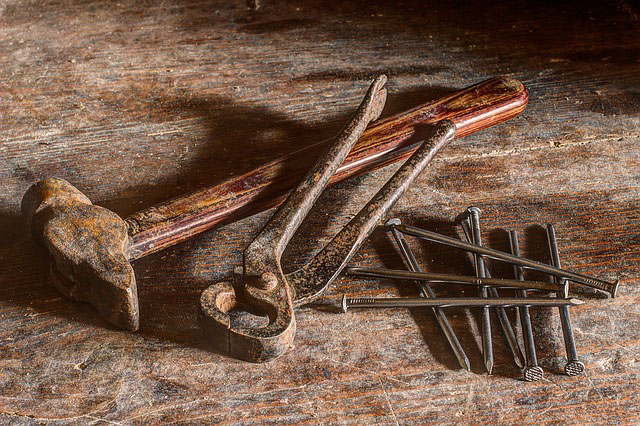Home renovations are demanding undertakings, and for all the larger scale projects you will, of course, call the professionals. Still, every home should have a basic toolkit in the case of some minor reparations, because, truly, there are many house improvement projects that fall within the DIY category. When setting up your basic toolkit, you should have in mind the functionality, affordability and durability. To prevent you from getting lost in the sea of all kinds of tools and fall victim to purchasing lavish toolkit all at once, we will give you a few hints on how to set up your own DIY kit from scratch.
Before you start stocking up with tools, consider how and where you will sort and store them. A toolbox or sturdy tool bag with plenty departments to keep your tools organized is one of the ways of doing that. For starters, you can use a simple drawer with some handy dividers. Who knows, you can even end up with a full-blown workshop and hang different tools on the wall. Also, think about your budget, because racking all the tools up at once can run you hundreds, even thousands of dollars, so you should consider searching for used tools at garage sales, flea markets, etc.
The Basic but Essential Tools for a Universal Toolbox for your Home
These are the basic tools you should have in your home regardless if you have some DIY projects planned, because they are actually intended for the unplanned situations. And truly, calling a handyman to hang a painting on the living room wall does seem silly. Instead, equip yourself with these tools and workout your DIY muscles from scratch.
- Screwdriver set – Screwdrivers are your everyday tools and you will need them for the most basic tasks, such as prying the lids off of paint cans, but also for the more demanding ones like fixing the door knob (just make sure you stop there and hire professionals for door replacement), etc. Aim for Philips-head and flat-head screwdrivers in different sizes.
- Claw Hammer – Whether we are talking about nails sticking out of a chair or hanging a painting on a wall, a hammer is an essential tool in every household. A claw hammer is a two-in-one package, because you can use it for pulling out the nails and driving them in. When buying a hammer search for rubber or plastic handle.
- Pliers – This tool’s function is, essentially, increasing the strength of your hand’s grip. Although there are many different kinds of pliers, for your basic tool box you should look for adjustable pliers that can be used as wire cutter, a clamp, etc. The recommended standard size of pliers is 5-10W.
- Adjustable crescent wrench – You will need this tool for loosening the plumbing fixtures, tightening nuts, auto repairs, assembling furniture, fixing bicycles, and similar tasks.
- Tape measure – Just in case when you need to “measure twice and cut once”. Just note that wider tapes are easier to support with one hand.
- Level – If you have ever had the case of a “crookedly hung photo” you will know how to appreciate the level. A basic old bubble model will do the trick, but if you are a high-tech aficionado, you can even opt for some of the modern laser alternatives.
- Utility knife – A utility knife with a rubber-covered handle will serve you great for everything from sharpening pencils to opening boxes.
- Flashlight – You can get a regular flashlight that you use for emergencies, but you can also get a headlamp or a work lamp when you are working in low light conditions.
When You Need to Take It Further…
When you become handy at doing your own house repairs, you can start upgrading your toolkit. For this endeavor you will need to invest a larger sum of money, but if you will be really dedicated to household projects, in the future, you may save money on professional repairs and renovations. Here are some of the tools you might need in that case.
- Electric drill – This is another tool that you can at first borrow, but sooner or later, you will find it indispensable for its multiple functions (drilling, driving screws, grinds materials, stirs paints, etc.). Although cordless drills are the most convenient, they can be rather expensive, while the corded kinds cost less and perform the same.
- Hacksaw – You will find a hacksaw quite useful when you need to cut through wood, pvc plastic pipes or metal. Look for the kind with easily replaceable blades. Depending on the materials you intend to cut, you can choose from regular blade (softer metals), raker (thick metals) and wavy (hard, thin metals).
- Ratcheting screwdriver – This tool lessens the stress on your wrists by locking into a place when you turn it clockwise and loosening when you turn counter. Search for a screwdriver with ergonomic handle, for a more comfortable grip.
- Stud finder – This is useful for securing cabinets, shelves, TVs, etc. This tool is actually a handled device for locating framing studs behind the final walling surface, so they can be really useful when tackling these sensitive tasks. You can choose between magnetic and electronic detectors.
- Other tools you might need – Some of the other tools you might find necessary along the way are pipe wrench, putty knife, chisel, combination square, crosscut saw, hex keys, circular saw, automatic nailer, staple gun, rubber mallet, etc.
- When it gets out of reach – There are some projects around the house that can prove to be too complicated, but are not done very often. In those cases, maybe you do not need to buy the tool but you can always rent it. Just imagine how much safer and more stable would be to have a scissor lift instead of ladder when you are fixing the roof, hanging Christmas lights on the second story, or need to reach some high area on the exterior of your home.
Now you are covered for most of the home improvement projects, but you can continue upgrading your toolbox as you are upgrading your skills and interests. And as your skills and your toolbox grow together, who knows, maybe you start seeing the repairs and renovation projects as something more than just a hobby!
What’s in your DIY Tool Kit?
Keep everything organized and within easy reach. These types of tool storage bags can be found online and at your major home improvement centers. Keeping everything in one place makes any project so much easier!
Guest Post by Chloe Taylor
Edited by M. Hill












